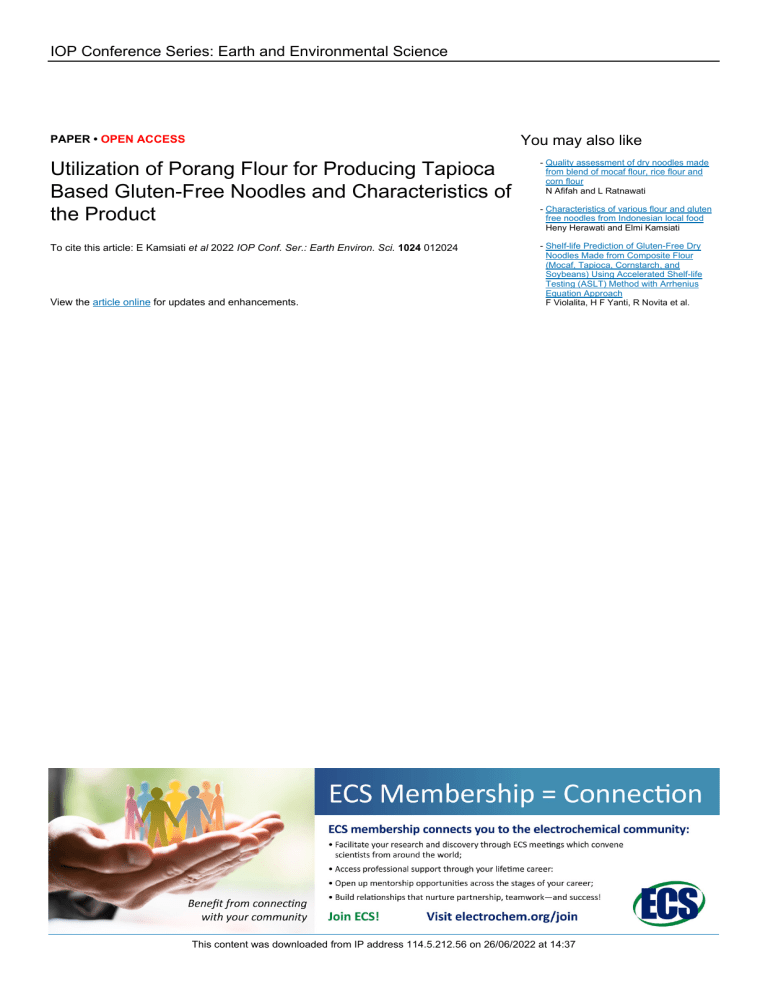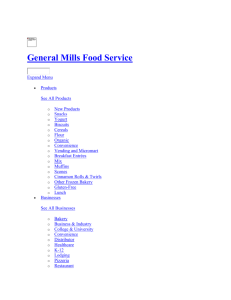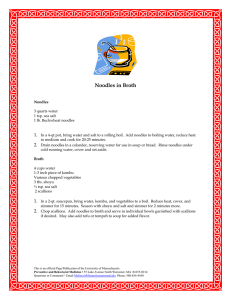
IOP Conference Series: Earth and Environmental Science You may also like PAPER • OPEN ACCESS Utilization of Porang Flour for Producing Tapioca Based Gluten-Free Noodles and Characteristics of the Product - Quality assessment of dry noodles made from blend of mocaf flour, rice flour and corn flour N Afifah and L Ratnawati To cite this article: E Kamsiati et al 2022 IOP Conf. Ser.: Earth Environ. Sci. 1024 012024 - Shelf-life Prediction of Gluten-Free Dry Noodles Made from Composite Flour (Mocaf, Tapioca, Cornstarch, and Soybeans) Using Accelerated Shelf-life Testing (ASLT) Method with Arrhenius Equation Approach F Violalita, H F Yanti, R Novita et al. View the article online for updates and enhancements. - Characteristics of various flour and gluten free noodles from Indonesian local food Heny Herawati and Elmi Kamsiati This content was downloaded from IP address 114.5.212.56 on 26/06/2022 at 14:37 The 3rd International Conference on Agricultural Postharvest Handling and Processing IOP Conf. Series: Earth and Environmental Science 1024 (2022) 012024 IOP Publishing doi:10.1088/1755-1315/1024/1/012024 Utilization of Porang Flour for Producing Tapioca Based Gluten-Free Noodles and Characteristics of the Product E Kamsiati1, S Widowati1, and H Herawati1 1Indonesian Center for Agricultural Postharvest Research and Development Jl. Tentara Pelajar 12, Cimanggu, Bogor 16114, West Java, Indonesia Email: elmikamsiati@gmail.com Abstract. Porang flour is an intermediate product of porang that has fairly high glucomannan content. Glucomannan was widely used as a gelling agent and stabilizer in food products. Glutenfree noodles were developed to fulfill the needs of healthy and specialty food segments. Generally, the gluten-free noodle uses local flour or starch as raw material. The challenge in the development of gluten-free noodles is the absence of gluten that affects the product texture. This study aims to determine the effect of porang flour on gluten-free noodles made from tapioca. This study was arranged in a completely randomized design with a proportion of konjac flour as the treatment. The treatments consist of 5%, 10%, 15%, and 20% porang flour compared to the control. The results showed that the proportion of porang flour had a significant effect on the texture and proximate content of the noodles. Noodles with the best texture were obtained using porang flour at 15%. It had a hardness of 0.824 N; Cohesiveness 0.704; Gumminess 0,411 N; Chewiness 0.168 mJ. That noodles had 7.165% moisture content ; 0.655% ash; 0.185% fat; 0.925% protein; 91.070% carbohydrates and 369.645% energy .[D4] 1. Introduction The development of gluten-free noodles aims to produce noodle products for special segments, namely people with celliac disease and also autism. Local flour and starch are sources of carbohydrates that can be used as raw materials for making gluten-free noodles. Tapioca is a starch derived from cassava. Tapioca is widely used as a raw material or additive in various food products.[1] In the wheat noodle production process, gluten plays a role in producing an elastic dough so as to produce noodles with a chewy texture and are not easily crushed when cooked. The obstacle in developing gluten-free noodles is the absence of gluten, so it is necessary to modify the formula and process to get a product with good characteristics[2]. In the development of gluten-free noodles, hydrocolloids and emulsifiers are added to improve the texture of the product. Polysaccharides and their derivatives as well as proteins can be used as ingredients in the manufacture of gluten-free noodles. Porang is one type of tuber plant that contains a lot of glucomannan. Glucomannan is a polysaccharide composed of glucose and mannose units that connected by β 1-4 linkage. Glucomannan is commonly used as a stabilizer, gelling agent and texturing agent in various food products. Glucomannan is also a natural fiber that is beneficial for health. Porang flour is the result of drying and flouring porang tubers. Porang flour contains 43-70% glucomannan ,[3], [4] The development of gluten-free noodles has been previously reported including the development of gluten-free cassava noodles [2] sorghum noodles [5]; and the development of corn noodles [6][7]. While research on the use of porang flour in the producction of noodles has previously been reported, including Content from this work may be used under the terms of the Creative Commons Attribution 3.0 licence. Any further distribution of this work must maintain attribution to the author(s) and the title of the work, journal citation and DOI. Published under licence by IOP Publishing Ltd 1 The 3rd International Conference on Agricultural Postharvest Handling and Processing IOP Conf. Series: Earth and Environmental Science 1024 (2022) 012024 IOP Publishing doi:10.1088/1755-1315/1024/1/012024 the production of porang noodles using the pregelatinization method [8]; addition of porang flour to noodles with mocaf substitution [9]; porang flour substitution in making wheat noodles [10]. Limited studies have reported the use of porang flour in making gluten-free noodles made from starch/tapioca.This study aims to determine the effect of the proportion of porang flour on the characteristics of gluten-free tapioca-based noodles. 2. Methods This research was carried out at the Postharvest Research and Development Research and Development Laboratory in January-June 2021. The materials used were Pak Tani brand tapioca, porang flour and refined salt. The equipment used are scales, basins, measuring cups, stoves, pans, renoodles, baking sheets and aisle dryers. While the analytical equipment used is a scale, oven, desiccator, Khjedal flask, Soxhlet, chromameter Minolta AMT501, texture analyzer. The study was arranged in a completely randomized design with 5 treatments, namely 5%, 10%, 15% and 20% porang flour substitution compared to the control. Each treatment has three replications. The process of making tapioca-based gluten-free with the addition of porang flour was as follows: tapioca added with porang flour and salt, mixed with 50% hot water until a dough was formed. Then the dough was molded using re-noodles to be wet noodle strands. The noodles were then dried using a dryer at 50°C for 3 hours. The dried noodles were packed in tight plastic for further analysis. Parameters observed were texture, colour, and proximate analysis. Color analysis using a chromameter Minolta AMT501 on parameters L, a, b, C and H. Texture using a Brookfield Model Texture Analyzer: CT-3 on parameters hardness, cohesiveness, springiness, gumminess and chewiness. Proximate analysis includes moisture content, ash content, fat content, protein content and carbohydrate content. The data obtained were analyzed by analysis of variance with = 5% using SPSS 22. 3. Results and Discussion 3.1. Texture The hardness of the noodles obtained ranged from 0.194-0.828 N. The results of the analysis of variance showed that the treatment had a significantly effect on hardness of the noodle. The use of porang flour tends to increase the hardness of the noodles produced. These results in line with the results of previous studies, where porang flour noodles have a higher hardness than wheat noodles [8]. The higher use of konjac flour tend to increase of the konjac noodle. [11] Table 1. Means of texture parameters of the noodle at various treatment Treatments Hardness Cohesiveness Springiness Gumminess 0,194±0,038a 0,016±0,006a 0,260±0,510a 0,032±0,072a Control Porang 5% 0,319±0,033a 0,010±0,007a 0,356±0,207a 0,003±0,002a Porang 10% 0,828±0,176d 0,000±0,000a 0,390±0,042b 0,002±0,001a Porang 15% 0,824±0,105c 0,704±0,394b 0,392±0,040b 0,411±0,348b Porang 20% 0,562±0,285b 0,002±0,005a 0,360±0,038b 0,094±0,226a Chewiness 0,000±0,000a 0,000±0,000a 0,000±0,000a 0,172±0,074a 0,000±0,000a The same letter in the same column behind mean value showed no significant difference (P> 0.05) Furthermore, the cohesiveness ranges from 0,000-0,704. The highest cohesiveness value was obtained from the using of 15% porang flour. The cohesiveness value shows the compactness of the noodle structure. The higher the value of cohesiveness shows the structure that more compact. The next parameter of texture is the springiness. The springiness value ranges from 0.260-0.390. The gumminess values of noodle ranged from 0.002 to 0.411. While the value of chewiness ranged from 0.000-0.172. The use of porang flour tends to improve the texture characteristics of the noodles produced. The results of the analysis of variance showed that the treatment gave significantly effects on all texture parameters. 2 The 3rd International Conference on Agricultural Postharvest Handling and Processing IOP Conf. Series: Earth and Environmental Science 1024 (2022) 012024 IOP Publishing doi:10.1088/1755-1315/1024/1/012024 Glucomannan is a hydrocolloid that has high water binding properties. In the process of making noodles, glucomannan will bind to starch and protein to produce a stronger texture. Glucomannan can produced strong gel structure that The strong texture results in noodles that don't break easily and crumble when cooked. [12]. The use of konjac flour tend to increase the panelist acceptance of noodle made from taro and wheat flour mix. [13] Texture is an important parameter in noodle products. Good quality noodles are noodles that not easily break not only in raw shape but also when its cooked. The use of porang flour by 15% produced noodles with the highest cohesiveness characteristic, namely 0.704. Likewise, the parameters of springiness, gumminess and chewiness. Therefore, the use of porang flour by 15% produces noodles with the best texture characteristics. 3.2. Color The observed noodle color parameters were Lightness (L), redness (a), yellowness (b), chromaticity index (C) and Hue (H) of the cooked noodles. Lightness (L) values ranged from 39,080-55,113. The addition of porang flour tends to increase the lightness of the resulting noodles. The results of the analysis of variance showed that the use of porang flour resulted in brighter noodles. Porang flour contains glucomannan which has high water binding ability and can form a gel. The resulting gel produces a brighter color in the resulting noodles. Table 2. Means of colour parameters of the noodle at various treatment Treatment L a b C 1 39,080±0,679 -6,570±0,740 1,133±0,636 6,700±0,685 2 45,017±0,304 -5,920±0,064 0,507±0,114 5,943±0,059 3 49,457±0,078 -4,437±0,062 2,183±0,073 5,100±0,224 4 53,967±0,506 -5,397±0,257 3,437±0,178 6,400±0,305 5 55,113±0,338 -4,597±0,054 3,647±0,179 5,870±0,092 H 169,887±5,894 175,057±1,141 154,543±2,008 147,497±0,342 141,587±1,611 Furthermore, on the redness parameter, it ranges from -4.597 to -6.570. The use of porang flour tends to produce noodles that have a higher level of redness. Then the yelowness value ranges from 0.507 to 3.647. The use of porang flour tends to increase the yellowness of the noodles produced. The results of the analysis of variance showed that the treatment had a significantly effect on the level of redness and yellowness of the noodles produced. Porang flour has a yellow and slightly reddish color, compared to tapioca which is white and transparent when cooked. The use of porang flour produces a slightly reddishyellow color of the noodles.[9] Chromaticity index (C) shows the level of color density of the resulting noodles. The chromaticity index ranges from 5,100-6,700. The results of the analysis of variance showed that the treatment had a significantly effect. Then on the Hue value, which shows the actual color, the resulting Hue value ranges from 141,587-175.057. This value indicates that the noodles tend to be yellowish in color. The results of the analysis of variance showed that the treatment had a significantly effect on the color of noodle. 3.3. Proximate content The moisture content of noodles ranges from 6.550-7.455%. The use of porang flour tends to increase the moisture content of the noodles. The results of the analysis of variance showed that the treatment had a significantly effect. Porang flour contains 40-70% glucomannan. High levels of glucomannan in noodles can bind water so that the addition of porang flour tends to produce higher moisture content. [14] 3 The 3rd International Conference on Agricultural Postharvest Handling and Processing IOP Conf. Series: Earth and Environmental Science 1024 (2022) 012024 IOP Publishing doi:10.1088/1755-1315/1024/1/012024 Table 3. Means of proximate parameters of the noodle at various treatment Treatments Moisture content (%) Ash content (%) Fat content (%) Protein content (%) Carbohydrat content (%) Control 6,550±0,030a 0,185±0,005b 0,115±0,005a 0,745±0,045ab 92,405±0,065e Porang 5% 7,235±0,025b 0,100±0,010a 0,100±0,010a 0,700±0,000a 91,865±0,025d Porang 10% 7,165±0,015b 0,655±0,005d 0,185±0,015c 0,925±0,045b 91,070±0,090c Porang 15% 7,4550±0,005c 0,545±0,005c 0,150±0,000b 1,660±0,090d 90,190±0,090a Porang 20% 7,210±0,020b 0,660±0,010d 0,080±0,010a 1,350±0,040c 90,700±0,080b The same letter in the same column behind mean value showed no significant difference (P> 0.05) Energy (kkal) 373,635±0,125d 371,160±0,01c 369,645±0,035b 368,750±0,000a 368,750±0,070a The ash content of the noodles ranged from 0.100-0.660%. The use of higher porang flour tends to increase the ash content of the noodles. The results of the analysis of variance showed that the addition of porang flour had a significant effect on the ash content of the noodles produced. The ash content of porang flour was 4.47%, whereas tapioca had 0,11-0,19% ash content. [3], [15] Furthermore, the fat content ranged from 0.080 to 0.185%. The results of the analysis of variance showed that the treatment had a significantly effect on fat content. The use of porang flour tends to increase the fat content of the noodles produced. Tapioca which is starch from cassava has a low content of fat (0.33-0.76%) the use of porang flour which has a fat content 2.98% can increase the fat content of the noodles produced. [3], [15] In terms of protein content, the noodles had protein content ranging from 0.700-1.660%. The increase in the use of porang flour resulted in higher protein content than the control. The results of the analysis of variance showed that the treatment had a significantly effect on protein content. Porang flour is the result of drying and grinding porang tubers, so that not only glucomannan, other components including protein are still present in porang flour. The protein content of porang flour was 3.34% Therefore, the use of porang flour tends to increase the protein content of the noodles produced.[3], [14], [15] Carbohydrate content ranged from 90.190-92.405%. The use of porang flour tends to reduce the carbohydrate content of the noodles produced. The results of the analysis of variance showed that the treatment had a significantly effect. The carbohydrate content in tapioca is higher than in porang flour, so the use of porang flour will reduce the carbohydrate content of the noodles produced. 4. Conclusion The use of porang flour had a significantly effect on the characteristics of texture, colour and proximate content of tapioca-based gluten-free noodles. The use of porang flour tends to increase the lightness of the resulting noodles. The use of porang flour also improves the texture characteristics of the resulting noodles. The use of porang flour by 15%, produces noodles with the best texture characteristics. The results of the proximate analysis also showed that the use of porang flour increased the water, ash, protein and fat content and reduced the carbohydrate content of the noodles produced. References [1] E. Syamsir, P. Hariyadi, and D. Fardiat 2009 J. Agrotek 5: 93–105,. [2] H. Herawati and E. Kamsiati 2021 12: 602–612, [3] S. B. Widjanarko, E. Widyastuti, and F. I. Rozaq 2015. J. Pangan dan Agroindustri 3: 867–877 [4] Y. A. Wigoeno, R. Azrianingsih, and A. Roosdiana 2013. J. Biotropika, vol. 1: 231–235, 2013. [5] E. Kamsiati, E. Rahayu, and H. Herawati 2021 Agrointek 15: 134–145 [6] Subarna and T. Muhandri 2013 J. Teknol. dan Ind. Pangan 24: 75–80 [7] Muhandri*, T., Subarna, Palupi,S N. 2013 J. Teknol. dan Ind. Pangan 24: 110–114 [8] B. Noriandita, S. Ummah, U. Purwandari, I. Maflahah, and R. Sidik 2013 Prosiding Seminar 4 The 3rd International Conference on Agricultural Postharvest Handling and Processing IOP Conf. Series: Earth and Environmental Science 1024 (2022) 012024 IOP Publishing doi:10.1088/1755-1315/1024/1/012024 Nasional Fakultas Pertanian Universitas Trunojoyo Madura 844–853. [9] A. Faridah and B. Widjanarko 2014, 2016 [10] R. R. Sihmawati, D. A. Rosida, T. Wiliana, and S. Panjaitan 2019 J. Tek. Ind. HEURISTIC 16: 45–55 [11] U. Purwandari et al. 2014 Int. Food Res. J. vol. 21. 4: 1623–1627 [12] D. Yang et al. 2017 Int. J. Mol. Sci. vol. 18 [13] F. S. Rejeki, E. R. Wedowati, D. Puspitasari, J. W. Kartika, and M. Revitriani 2021 IOP Conf. Ser. Earth Environ. Sci 733 [14] T. W. S. Panjaitan, D. A. Rosida, and R. Widodo 2017 J. Tek. Ind. HEURISTIC 14: 1–16 [15] E. Syamsir, P. Hariyadi, D. Fardiaz, N. Andarwulan, and F. Kusnandar 2011 Karakterisasi tapioka dari lima varietas ubi kayu (Manihot utilisima Crantz) asal Lampung 5


